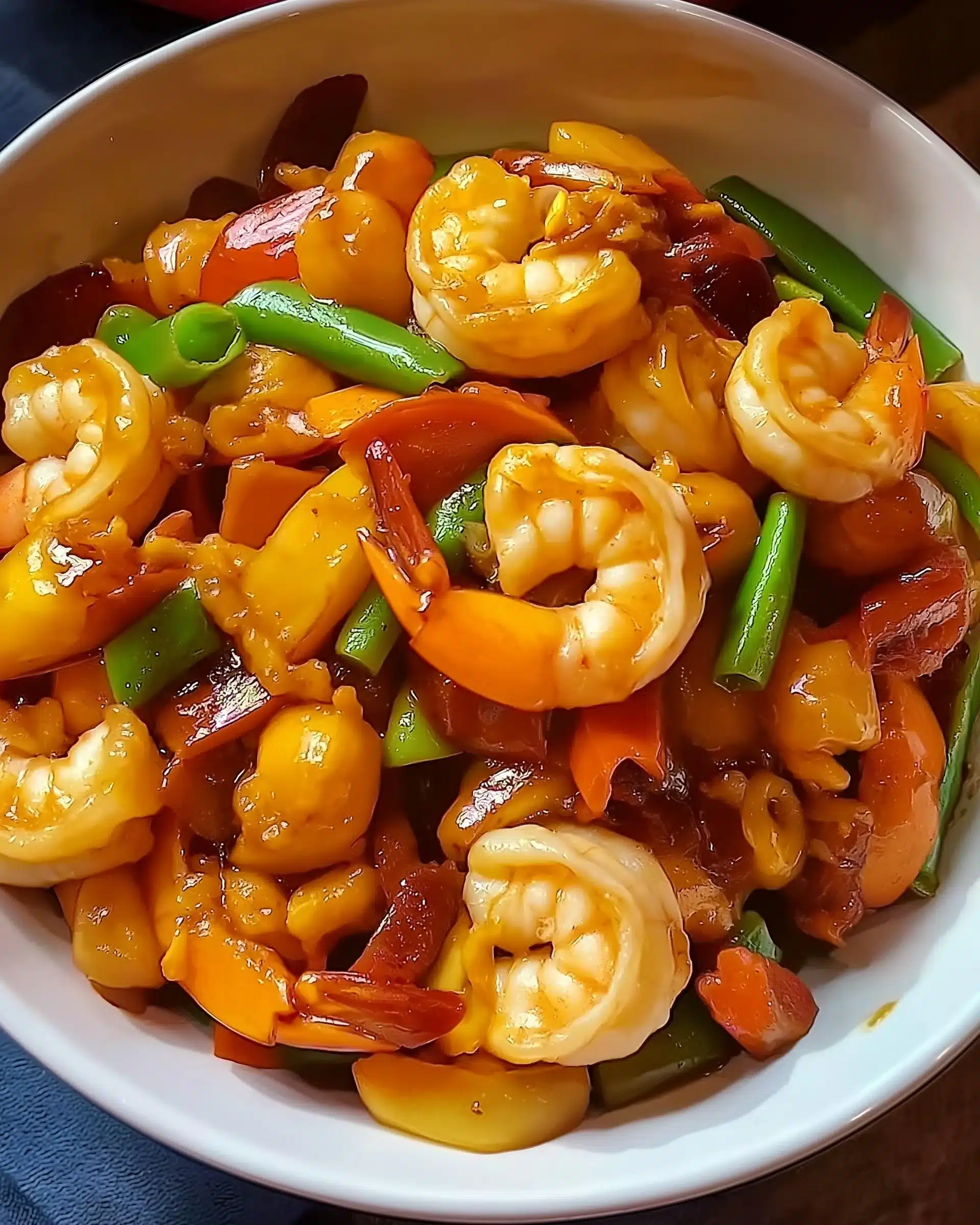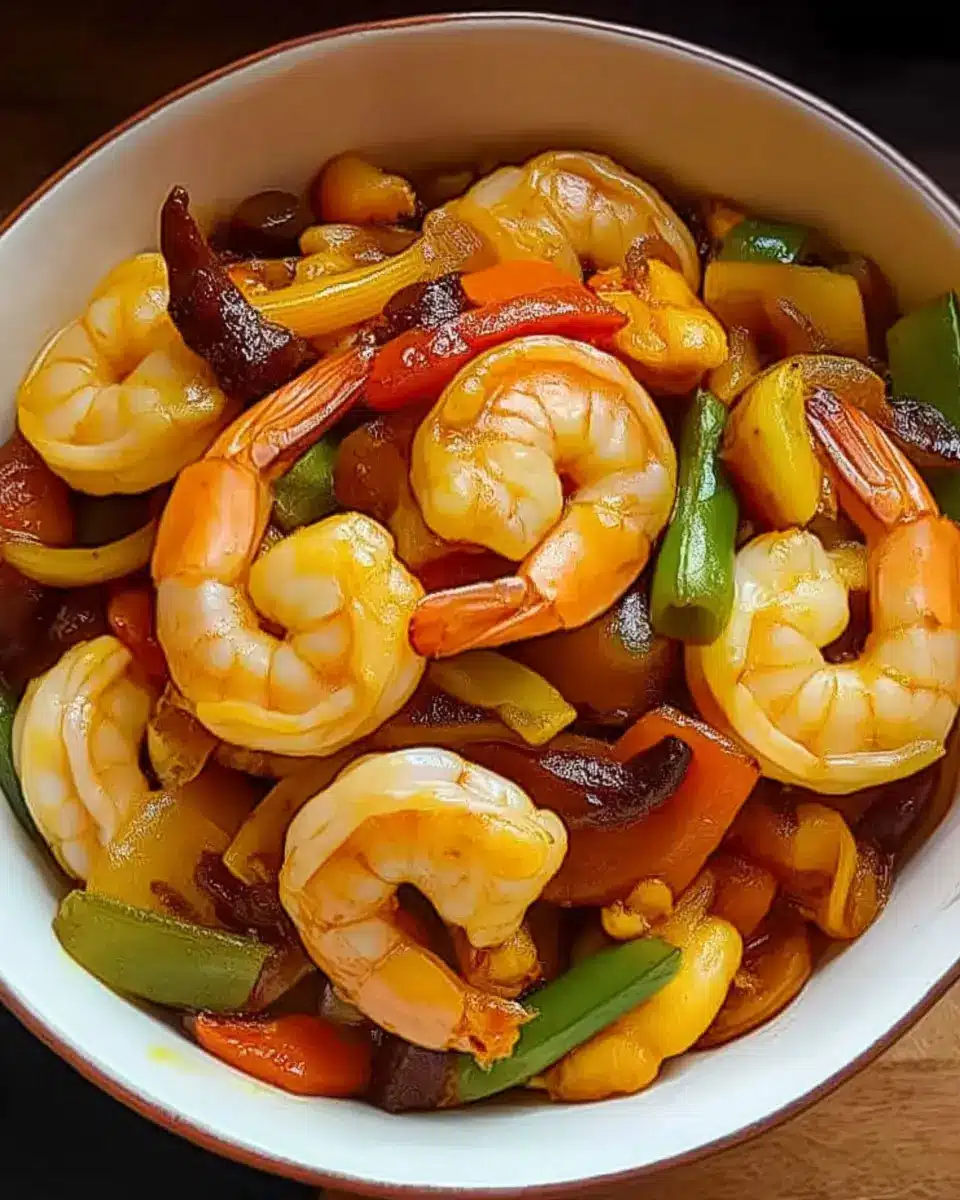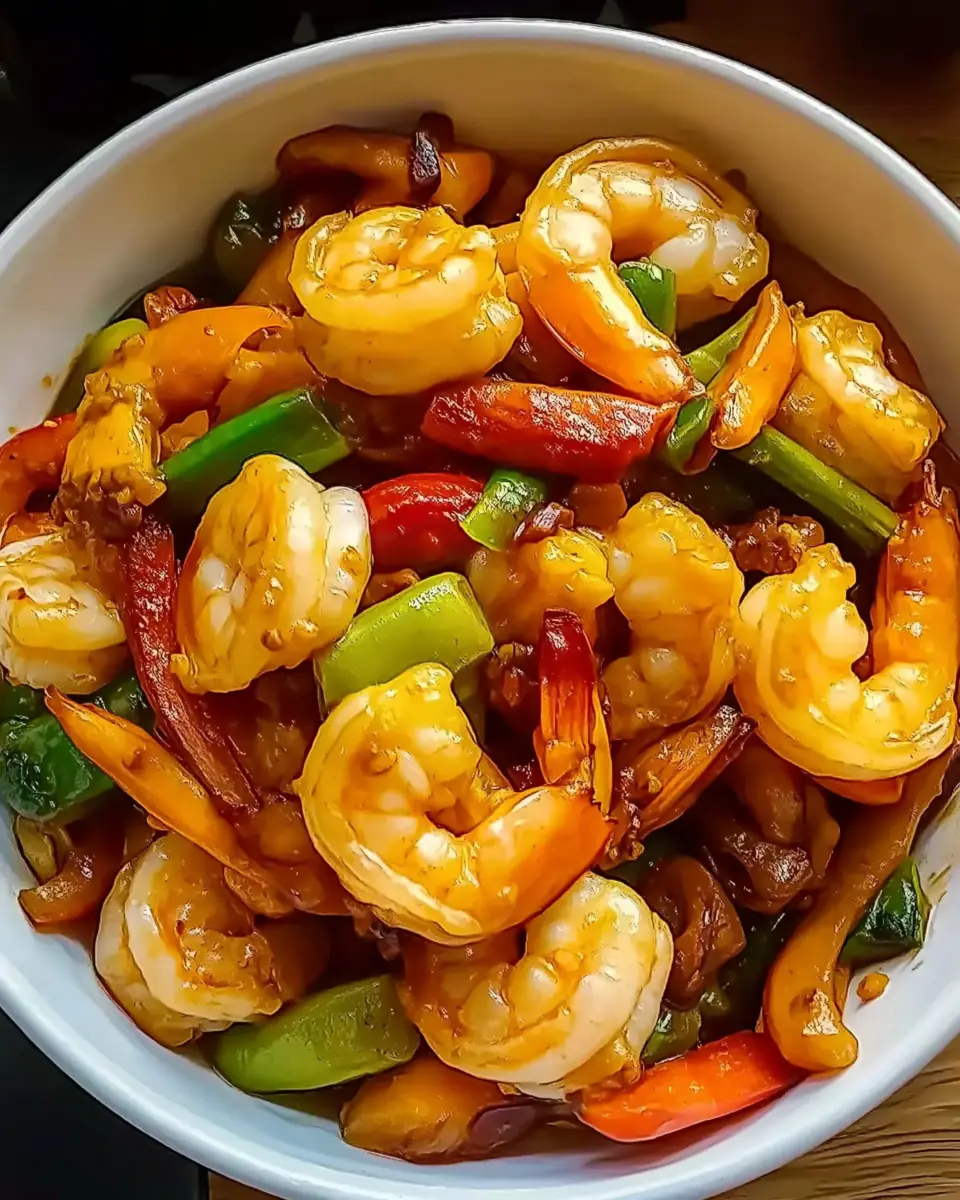
Introduction to Kung Pao Shrimp
There’s something magical about a dish that brings together bold flavors and vibrant colors, and Kung Pao Shrimp does just that. I remember the first time I tried this dish at a local Chinese restaurant; the combination of tender shrimp, crunchy vegetables, and that savory sauce left me craving more. This recipe is perfect for those busy weeknights when you want to whip up something quick yet impressive. With just a handful of ingredients and a mere 20 minutes, you can create a meal that will have your loved ones asking for seconds. Let’s dive into this culinary adventure!
Why You’ll Love This Kung Pao Shrimp
This Kung Pao Shrimp recipe is a game-changer for anyone looking to elevate their weeknight dinners. It’s quick, taking only 20 minutes from start to finish, making it perfect for those hectic evenings. The flavors are bold yet balanced, with a delightful crunch from the vegetables and peanuts. Plus, it’s a low-calorie option that doesn’t skimp on taste, ensuring you can indulge without the guilt. What’s not to love?
Ingredients for Kung Pao Shrimp
Gathering the right ingredients is key to making a delicious Kung Pao Shrimp. Here’s what you’ll need:
- Shrimp: Large, peeled, and deveined shrimp are the stars of this dish. They cook quickly and soak up all the flavors.
- Soy Sauce: This adds a savory depth to the dish. Opt for low-sodium if you’re watching your salt intake.
- Rice Vinegar: A splash of this tangy vinegar brightens the flavors and balances the richness of the sauce.
- Cornstarch: This helps to create a nice coating on the shrimp, giving them a slightly crispy texture when cooked.
- Vegetable Oil: A neutral oil is best for stir-frying. It allows the other flavors to shine without overpowering them.
- Bell Pepper: Any color works! They add sweetness and crunch, making the dish visually appealing.
- Snap Peas: These tender-crisp peas bring a fresh, sweet flavor and a pop of color to the mix.
- Garlic: Minced garlic adds a fragrant aroma and depth of flavor that’s hard to resist.
- Fresh Ginger: A little ginger goes a long way in adding warmth and spice to the dish.
- Roasted Peanuts: These provide a delightful crunch and nutty flavor, making every bite satisfying.
- Hoisin Sauce: This sweet and savory sauce adds complexity and richness to the overall flavor profile.
- Red Pepper Flakes: Adjust these to your heat preference. They add a nice kick to the dish.
- Green Onions: Sliced green onions are perfect for garnishing, adding a fresh, mild onion flavor.
For those looking to mix things up, consider adding a splash of sesame oil for extra flavor or swapping shrimp for tofu or tempeh for a vegetarian twist. You can find the exact quantities of these ingredients at the bottom of the article, ready for printing!
How to Make Kung Pao Shrimp
Now that you have all your ingredients ready, let’s get cooking! This Kung Pao Shrimp recipe is straightforward and fun. Follow these steps, and you’ll have a delicious meal in no time.
Step 1: Marinate the Shrimp
Start by placing the shrimp in a medium bowl. Add soy sauce, rice vinegar, and cornstarch. Toss everything together until the shrimp are well coated. This marinating step is crucial; it infuses the shrimp with flavor and helps create that delightful texture. Let it sit for about 5 minutes while you prepare the other ingredients.
Step 2: Cook the Shrimp
Heat vegetable oil in a large skillet or wok over medium-high heat. Once the oil is hot, add the marinated shrimp. Cook for 2-3 minutes, stirring occasionally, until they turn pink and opaque. Be careful not to overcook them; shrimp can become rubbery if left too long. Once cooked, remove the shrimp from the skillet and set them aside.
Step 3: Stir-Fry the Vegetables
In the same skillet, toss in the diced bell pepper, snap peas, minced garlic, and ginger. Stir-fry these vibrant veggies for about 3-4 minutes. You want them to be tender-crisp, retaining that satisfying crunch. This step not only adds flavor but also keeps the dish colorful and appealing.
Step 4: Combine and Heat Through
Return the cooked shrimp to the skillet with the vegetables. Now, add hoisin sauce, red pepper flakes, and roasted peanuts. Stir everything together, ensuring the shrimp and veggies are well coated in the sauce. Heat through for another 2 minutes, allowing the flavors to meld beautifully.
Step 5: Garnish and Serve
Finally, it’s time to plate your masterpiece! Garnish with sliced green onions for a fresh touch. Serve your Kung Pao Shrimp over cooked rice or quinoa for a complete meal. Enjoy the burst of flavors and the satisfaction of a home-cooked dish!

Tips for Success
- Prep all ingredients before cooking to streamline the process.
- Use a high smoke point oil for stir-frying to prevent burning.
- Don’t overcrowd the skillet; cook in batches if necessary.
- Adjust red pepper flakes to suit your heat preference.
- For extra flavor, add a splash of sesame oil just before serving.
Equipment Needed
- Large Skillet or Wok: Essential for stir-frying. A non-stick skillet works well too.
- Medium Bowl: For marinating the shrimp. Any mixing bowl will do.
- Spatula or Wooden Spoon: Perfect for stirring and flipping ingredients.
- Measuring Spoons: Handy for accurate ingredient measurements.
Variations
- Vegetarian Option: Swap shrimp for tofu or tempeh. Both options absorb flavors beautifully and provide a satisfying texture.
- Spicy Kick: Add sliced fresh chili peppers or increase the red pepper flakes for an extra heat boost.
- Nut-Free Version: Omit the peanuts and replace them with sunflower seeds for a similar crunch without the nuts.
- Extra Veggies: Incorporate additional vegetables like broccoli, carrots, or zucchini for more color and nutrition.
- Gluten-Free: Use tamari instead of soy sauce to make this dish gluten-free while keeping the flavor intact.
Serving Suggestions
- Rice or Quinoa: Serve your Kung Pao Shrimp over fluffy white rice or nutty quinoa for a hearty base.
- Steamed Vegetables: Pair with steamed broccoli or bok choy for added nutrition and color.
- Refreshing Drink: Enjoy with a cold beer or a light iced tea to balance the flavors.
- Presentation: Garnish with extra green onions and serve in a colorful bowl for an eye-catching display.

FAQs about Kung Pao Shrimp
Can I make Kung Pao Shrimp ahead of time?
While it’s best enjoyed fresh, you can prepare the shrimp and vegetables in advance. Just store them separately in the fridge. When you’re ready to eat, stir-fry them together for a quick meal.
What can I substitute for shrimp in this recipe?
If you’re looking for a vegetarian option, tofu or tempeh works wonderfully. Both absorb flavors well and provide a satisfying texture, making them great substitutes in this Kung Pao Shrimp recipe.
How spicy is Kung Pao Shrimp?
The spice level can be adjusted to your liking. The red pepper flakes add a nice kick, but you can reduce or increase them based on your heat preference. For an extra spicy version, consider adding fresh chili peppers.
Can I freeze Kung Pao Shrimp?
Yes, you can freeze Kung Pao Shrimp! Just make sure to store it in an airtight container. When you’re ready to enjoy it, thaw in the fridge and reheat in a skillet for the best texture.
What should I serve with Kung Pao Shrimp?
This dish pairs beautifully with steamed rice or quinoa. You can also serve it alongside fresh vegetables or a light salad to balance the flavors and add some crunch.
Final Thoughts
Cooking Kung Pao Shrimp is more than just preparing a meal; it’s about creating a moment of joy in your kitchen. The vibrant colors and bold flavors come together to make a dish that’s not only satisfying but also a feast for the senses. Whether you’re impressing guests or enjoying a cozy dinner at home, this recipe delivers every time. Plus, it’s quick enough to fit into your busy schedule. So, roll up your sleeves, embrace the sizzle of the skillet, and let the delightful aroma fill your home. You’ll be glad you did!
Kung Pao Shrimp: Discover This Flavorful Recipe Today!
Ingredients
Method
- In a medium bowl, combine shrimp, soy sauce, rice vinegar, and cornstarch. Toss to coat and let marinate for 5 minutes.
- Heat vegetable oil in a large skillet or wok over medium-high heat. Add the marinated shrimp and cook for 2-3 minutes until they turn pink and opaque. Remove shrimp from the skillet and set aside.
- In the same skillet, add bell pepper, snap peas, garlic, and ginger. Stir-fry for 3-4 minutes until vegetables are tender-crisp.
- Return the shrimp to the skillet and add hoisin sauce, red pepper flakes, and peanuts. Stir well to combine and heat through for another 2 minutes.
- Garnish with sliced green onions before serving.
Nutrition
Notes
- This dish is best served immediately over cooked rice or quinoa.
- To enhance the flavor, consider adding a splash of sesame oil before serving.
- For a vegetarian option, substitute shrimp with tofu or tempeh.

